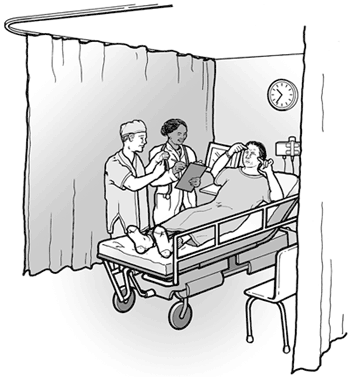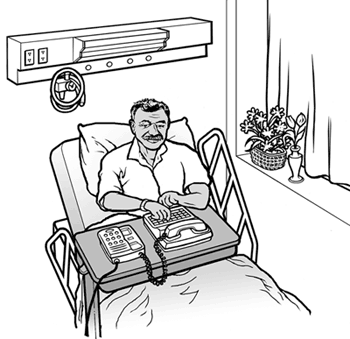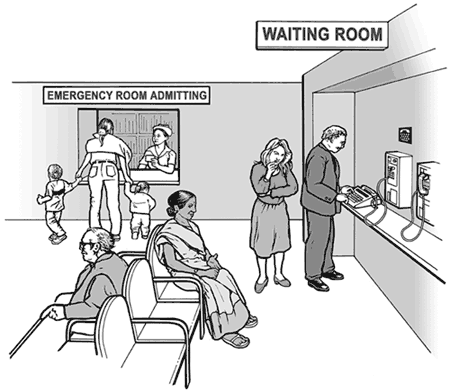ADA Business BRIEF: Communicating with People Who Are Deaf or Hard of Hearing in Hospital Settings

U.S. Department of Justice
Civil Rights Division
Disability Rights Section
Americans with Disabilities Act
ADA Business BRIEF:
Communicating with People Who Are Deaf or Hard of Hearing in Hospital Settings
People who are deaf or hard of hearing use a variety of ways to communicate. Some rely on sign language interpreters or assistive listening devices; some rely primarily on written messages. Many can speak even though they cannot hear. The method of communication and the services or aids the hospital must provide will vary depending upon the abilities of the person who is deaf or hard of hearing and on the complexity and nature of the communications that are required. Effective communication is particularly critical in health care settings where miscommunication may lead to misdiagnosis and improper or delayed medical treatment.
Under the Americans with Disabilities Act (ADA), hospitals must provide effective means of communication for patients, family members, and hospital visitors who are deaf or hard of hearing.
The ADA applies to all hospital programs and services, such as emergency room care, inpatient and outpatient services, surgery, clinics, educational classes, and cafeteria and gift shop services. Wherever patients, their family members, companions, or members of the public are interacting with hospital staff, the hospital is obligated to provide effective communication.
Exchanging written notes or pointing to items for purchase will likely be effective communication for brief and relatively simple face-to-face conversations, such as a visitor’s inquiry about a patient’s room number or a purchase in the gift shop or cafeteria.
Written forms or information sheets may provide effective communication in situations where there is little call for interactive communication, such as providing billing and insurance information or filling out admission forms and medical history inquiries.
For more complicated and interactive communications, such as a patient’s discussion of symptoms with medical personnel, a physician’s presentation of diagnosis and treatment options to patients or family members, or a group therapy session, it may be necessary to provide a qualified sign language interpreter or other interpreter.
Sign language interpreters
Sign language is used by many people who are deaf or hard of hearing. It is a visually interactive language that uses a combination of hand motions, body gestures, and facial expressions. There are several different types of sign language, including American Sign Language (ASL) and Signed English.
Oral interpreters
Not all people who are deaf or hard of hearing are trained in sign language. Some individuals with hearing disabilities are trained in speech reading (lip reading) and can understand spoken words fairly well with assistance from an oral interpreter. Oral interpreters are specially trained to articulate speech silently and clearly, sometimes rephrasing words or phrases to give higher visibility on the lips. Natural body language and gestures are also used.
Cued speech interpreters
A cued speech interpreter functions in the same manner as an oral interpreter except that he or she also uses a hand code, or cue, to represent each speech sound.
Computer Assisted Real-time Transcription (CART)
Many people who are deaf or hard of hearing are not trained in either sign language or speech reading. CART is a service in which an operator types what is said into a computer that displays the typed words on a screen.
Situations where an interpreter may be required for effective communication:
• discussing a patient’s symptoms and medical condition, medications, and medical history
• explaining and describing medical conditions, tests, treatment options, medications, surgery and other procedures
• providing a diagnosis, prognosis, and recommendation for treatment
• obtaining informed consent for treatment
• communicating with a patient during treatment , testing procedures, and during physician’s rounds
• providing instructions for medications, post-treatment activities, and follow-up treatments
• providing mental health services, including group or individual therapy, or counseling for patients and family members
• providing information about blood or organ donations
• explaining living wills and powers of attorney
• discussing complex billing or insurance matters
• making educational presentations, such as birthing and new parent classes, nutrition and weight management counseling, and CPR and first aid training

A doctor uses a sign language interpreter to communicate with a patient who is deaf.
Hospitals may need to provide an interpreter or other assistive service in a variety of situations where it is a family member or companion rather than the patient who is deaf or hard of hearing. For example, an interpreter may be necessary to communicate where the guardian of a minor patient is deaf, to discuss prognosis and treatment options with a patient’s spouse or partner who is hard of hearing, or to allow meaningful participation in a birthing class for a prospective new father who is deaf.
Individuals with hearing disabilities have different communication skills and the hospital should consult with each individual to determine what aids or services are necessary to provide effective communication in particular situations.
Sign language or other interpreters must be qualified. An interpreter is qualified if he or she can interpret competently, accurately, and impartially. In the hospital setting, the interpreter must be familiar with any specialized vocabulary used and must be able to interpret medical terms and concepts. Hospital personnel who have a limited familiarity with sign language should interpret only in emergency situations for a brief time until a qualified interpreter can be present.
It is inappropriate to ask family members or other companions to interpret for a person who is deaf or hard of hearing. Family members may be unable to interpret accurately in the emotional situation that often exists in a medical emergency.
Hospitals should have arrangements in place to ensure that qualified interpreters are readily available on a scheduled basis and on an unscheduled basis with minimal delay, including on-call arrangements for after-hours emergencies. Larger facilities may choose to have interpreters on staff.
For training or other educational services offered to patients or members of the public, additional aids and services such as note takers, captioned videos, and assistive listening systems may be necessary for effective communication.
Hospitals should develop protocols and provide training to ensure that staff know how to obtain interpreter services and other communication aids and services when needed by persons who are deaf or hard of hearing.
It is helpful to have signs and other types of notices to advise persons with disabilities that services and assistance are available and what they need to do to obtain them. It is most useful to post signs at locations where patients or visitors typically seek information or assistance and to include information in general information packets.
Hospitals cannot charge patients or other persons with hearing disabilities an extra fee for interpreter services or other communication aids and services.
For telephone communications, many people who are deaf or hard of hearing use a teletypewriter (TTY, also known as a TDD) rather than a standard telephone. These devices have a keyboard and a visual display for exchanging written messages over the telephone.

A hospital patient uses a TTY in his hospital room.
The ADA established a free nationwide relay network to handle voice-to-TTY and TTY-to-voice calls. Individuals may use this network to call the hospital from a TTY. The relay consists of an operator with a TTY who receives the call from a TTY user and then places the call to the hospital. The caller types the message into the TTY and the operator relays the message by voice to the hospital staff person, listens to the staff person’s response, and types the response back to the caller. The hospital must be prepared to make and receive relay system calls, which may take a little longer than voice calls. For outgoing calls to a TTY user, simply dial 7-1-1 to reach a relay operator.
If telephones and televisions are provided in patient rooms, the hospital must provide patients who are deaf or hard of hearing comparable accessible equipment upon request, including TTY’s, telephones that are hearing-aid compatible and have volume control, and televisions with closed captioning or decoders.

A man uses a TTY that is connected to a pay telephone in a hospital emergency room waiting area.
Visual alarms are not required in patient rooms. However, hospital evacuation procedures should include specific measures to ensure the safety of patients and visitors who are deaf or hard of hearing.
A hospital need not provide communication aids or services if doing so would fundamentally alter the nature of the goods or services offered or would result in an undue burden.
Certain built-in communication features are required for hospitals built or altered after the effective date of the ADA:
• Visual alarms must be provided in all public and common-use areas, including restrooms, where audible alarms are provided.
• TTY’s must be provided at public pay phones serving emergency, recovery, or waiting rooms and at least one TTY must be provided at other locations where there are four or more pay phones.
• A certain percentage of public phones must have other features, such as TTY plug-in capability, volume controls, and hearing-aid compatibility. Consult the ADA Standards for Accessible Design for more specific information. [ADA Standards 4.1.3(17), 4.31]
ADA Information
You may view or download ADA information on the ADA website. This website provides access to the ADA Business Connection, ADA design standards, regulations, policy letters, technical assistance materials, and general ADA information. It also provides links to other Federal agencies and news about new ADA requirements and enforcement efforts.
If you have specific questions concerning the ADA, call the Department of Justice ADA Information Line.
(800) 514-0301 (voice)
(800) 514-0383 (TTY)
Duplication is encouraged
Acrobat PDF version for printing
October 2003

User Comments/Questions
Add Comment/Question